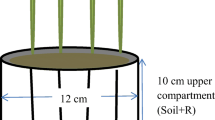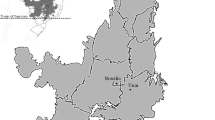Abstract
This study compared the validity of using the isotopically exchangeable phosphorus (P) as an accurate measurement of plant available P by comparing the specific activity of P, i.e. the 32P/31P ratio, in soil solution (Ss) against the specific activity of P in plants (Sp) growing in a loamy soil after applying a 32P-labelled fertilizer (NaH2PO42H2O) at different rates (F) and specific activities (Sf). Non-mycorrhizal and mycorrhizal (Glomus intraradices) plants of two species (soybean and barley) were grown in greenhouse experiments. Ss values were determined on 1:10 soil suspension after periods of incubation ranged from 1 min to 35 d. At a given rate of P application, the Sp values of both non-mycorrhizal and mycorrhizal soybean and barley did not show significant difference although the plant P uptake varied 18 fold for all the (crop species × mycorrhizal infection) treatments over soil solution P values ranging from 0.02 to 5.46 mg P L-1 (0.6–176 μM). Ss values decreased with time and reached a steady state after 35 d of equilibration period. Both Sp/Sf and Ss/Sf increased with applied P and there is a 1:1 correspondence between Sp/Sf and Ss/Sf values. The identity between the isotopic composition of both P in soil solution and in plant indicates that the isotopically exchangeable P (E=F(Sf/Ss−1)) is the only source of phosphate in solid soil phase which replenishes P of the soil solution after P has been removed by the plant, i.e. the only source of P which participates in plant nutrition. The isotopically exchangeable P of a loamy soil is the P available to growing plants and mycorrhizal fungi increases the P uptake giving plants wider access to isotopically exchangeable P in soil, and not making previously non-exchangeable P available. An immediate application of the 1:1 correspondence between a soil parameter (Ss/Sf) and a plant parameter (Sp/Sf) concerns the agronomic evaluation of P fertilizers.
Similar content being viewed by others
Abbreviations
- R:
-
amount of 32P associated with the amount of 31P (F) in fertilizer
- Rp:
-
amount of 32P taken up by plant
- Rs:
-
amount of 32P in soil solution
- Qf:
-
amount of 31P taken up by plant from the fertilizer (Qf=FRp/R)
- Qs:
-
amount of 31P taken up by plant from the soil
- Qt:
-
total amount of 31P taken up by plant (Qt=Qs+Qf)
- Wf:
-
amount of 31P in soil solution derived from the fertilizer (Wf=FRs/R)
- Ws:
-
amount of 31P in soil solution originated from the soil
- Wt:
-
total amount of 31P in soil solution (Wt=Ws+Wf)
- Sf:
-
specific activity of P in the applied fertilizer (Sf=R/F)
- Ss:
-
specific activity of P in the soil solution (Ss=Rs/Wt)
- Sp:
-
specific activity of P taken up by the plant (Sp=Rp/Qt)
- A value:
-
FQs/Qf
- L value:
-
F(Sf/Sp−1)
- E value:
-
F(Sf/Ss-1)
References
Barber, S A 1984 Soil Nutrient Bioavailability. A mechanistic approach. Wiley Interscience and Sons, New-York. 398 p.
Barrow, N J and Shaw, T C 1975 The slow reactions between soil and anions: 2. Effect of time and temperature on the decrease in phosphate concentration in the soil solution. Soil Sci. 119, 167–177.
Blal, B, Morel, C, Gianinazzi-Pearson, V, Fardeau, J C and Gianinnazi, S 1990 Influence of vesicular-arbuscular mycorrhizae on phosphate fertilizer efficiency in two tropical acid soils planted with micropropagated oil palm (Elais guineensis Jacq.). Biol. Fertil. Soils 43, 43–48.
Bolan, N S, Robson, A D, Barrow, N J and Aylmore, L A G 1984 Specific activity of phosphorus in mycorrhizal and non-mycorrhizal plants in relation to the availability of phosphorus to plants Soil Biol. Biochem. 16, 299–304.
Bolan, N S 1991 A critical review on the role of mycorrhizal fungi in the uptake of phosphorus by plants. Plant and Soil 134, 189–207.
Bolland, M D A and Gilkes, R J 1987 How effective are calciphos and phospal? Fertil. Res. 12, 229–239.
Dean, L A, Nelson, W L, Mackenzie, A J, Armiger, W H and Hill, W L 1947 Application of radioactive tracer technique to studies of phosphatic fertilizer utilization by crops. Soil Sci. Soc. Am. Proc. 12, 107–112.
Fardeau, J C and Guiraud, G 1972 Determination of available soil and fertilizers phosphorus by the isotopic dilution method. Phosphorus in Agric. 60, 19–26.
Fardeau, J C and Jappe, J 1976 Nouvelle méthode de détermination du phosphore assimilable du sol par les plantes: extrapolation des cinétiques de dilution isotopique. C.R. Séances Acad. Sci. série D, 282, 1137–1140.
Fardeau, J C 1981 Cinétique de dilution isotopique et phosphore assimilable des sols. Thèse de Doctorat d'Etat. Université P. et M. Curie, Paris 6, 198p.
Fardeau, J C 1993 Le phosphore biodisponible du sol: un système pluricompartimental à structure mamellaire. Agronomie 1, 1–13.
Fox, R L and E JKamprath 1970 Phosphate sorption isotherm for evaluating the phosphate requirements of soil. Soil Sci. Soc. Am. J. 70, 902–906.
Fried, M and Dean, L A 1952 A concept concerning the measurement of available soil nutrients. Soil Sci. 73, 263–271.
Giovanetti, M and Mosse, B 1980 An evaluation of techniques for measuring vesicular-arbuscular mycorrhizal infection in roots. New Phytol. 84, 489–500.
Hayman, D S and Mosse, B 1972 Plant growth response to vesicular-arbuscular mycorrhiza. III. Increased uptake of labile P from soil. New Phytol. 71, 41–47.
Hewitt, E J 1966 Sand and Water culture Methods used in the Study of Plant Nutrition. Tech. Comm. 22 (2nd revised Edition). Commonwealth Agricultural Bureaux, London.
Hoffland, E 1992 Quantitative evaluation of the role of organic acid exudation in the mobilization of rock phosphate by rape. Plant and Soil 140, 279–289.
John, M K 1970 Colorimetric determination of phosphorus in soil and plant material with ascorbic acid. Soil Sci. 68, 171–177.
Kalra, Y P and Soper, R J 1968 Efficiency of rape, oats, soybeans and flax in absorbing soil and fertilizer phosphorus at seven stage of growth. Agron. J. 60, 209–212.
Kalra, Y P 1971 Different behaviour of crop species in phosphate absorption. Plant and Soil 34, 535–539.
Kamprath, E J and Watson, M E 1980 Conventionnal soil and tissue tests for assessing the phosphorus status of soils. In the Role of Phosphorus in Agriculture. Eds. F E Khasawneh, E C Sample and E J Kamprath. pp 433–469. ASA Madison, WI.
Larsen, S 1952 The use of 32P in studies on the uptake of phosphorus by plants. Plant and Soil 4, 1–10.
Memon, K S and Fox, R L 1983 Utility of phosphate sorption curves in estimating the phosphorus requirements of cereal crops: wheat (Triticum aestivum). In Comptes Rendus du 3eme Congres sur les Composes Phosphates. pp 217–230. Imphos Casablanca, Morocco.
Morel, C and Fardeau, J C 1989 Native soil and fresh fertilizer phosphorus uptake as affected by rate of application and P fertilizers. Plant and Soil 115, 123–128.
Morel, C and Fardeau, J C 1990 Uptake of phosphate from soils and fertilizers as affected by P availability and solubility of phosphorus fertilizers. Plant and Soil 121, 217–224.
Morel, C and Fardeau, J C 1991 Phosphorus bioavailability of fertilizers: a predictive laboratory method for its evaluation. Fertil. Res. 28, 1–9.
Nelson, W L, Krakntz, B A, Colwell, W E, Woltz, W G, Hawkins, A, Dean, L A, Mackenzie, A J and Rubins, E J 1947 Application of radioactive tracer technique to studies of phosphatic fertilizer utilization by crops: field experiments. Soil Sci. Soc. Am. Proc. 12, 113–118.
Plenchette, C, Fortin, A and Furlan, V 1983 Growth responses of several plant species to mycorrhizae in a soil of moderate P-fertility. I. mycorrhizal dependency under field conditions. Plant and Soil 70, 199–209.
Powell, C L 1975 Plant growth responses to vesicular-arbuscular mycorrhiza. VII. Uptake of P by onion and clover infected with different Endogone spore types in 32P labelled soils. New Phytol. 75, 563–566.
Russell, R S, Rickson, J B and Adams, S N 1954 Isotope equilibrium between phosphate in soil and their significance in the assessment of fertility by tracer methods. J. Soil Sci. 67, 1–16.
SAS Institue Inc 1987 SAS/STAT Guide for personal computer. Version 6 Edition. Cray, NC: SAS Institute Inc. 1028 p.
Sanders, F E and Tinker, B P 1971 Mechanism of absorption of phosphate from soil by Endogone mycorrhizas. Nature 233, 278–279.
Soper, R J and Kalra, Y P 1969 Effect of mode of application and source of fertilizer on phosphorus utilization by buckwheat, rape, oats and flax. Can. J. Soil Sci. 49, 319–326.
Terman G L and Englestad O P 1976 Agronomic Evaluation of Fertilizers: Principles and Practices. Bull. Y-21 TVA, Muscle Shoals, Alabama. 45 p.
Welch, C D, Hall, N S and Nelson, W L 1949 Utilization of fertilizer and soil phosphorus by soybeans. Soil Sci. Soc. Am. Proc. 13, 231–235.
Author information
Authors and Affiliations
Rights and permissions
About this article
Cite this article
Morel, C., Plenchette, C. Is the isotopically exchangeable phosphate of a loamy soil the plant-available P?. Plant Soil 158, 287–297 (1994). https://doi.org/10.1007/BF00009502
Received:
Accepted:
Issue Date:
DOI: https://doi.org/10.1007/BF00009502




